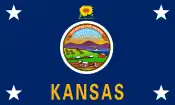Henry Justin Allen
Henry Justin Allen (September 11, 1868 – January 17, 1950) was the 21st Governor of Kansas (1919–1923) and U.S. Senator from Kansas (1929–30).[1]
Henry Allen | |
|---|---|
.jpg.webp) | |
| United States Senator from Kansas | |
| In office April 1, 1929 – November 30, 1930 | |
| Preceded by | Charles Curtis |
| Succeeded by | George McGill |
| Chair of the National Governors Association | |
| In office 1919 | |
| Preceded by | Emerson Harrington |
| Succeeded by | William Cameron Sproul |
| 21st Governor of Kansas | |
| In office January 13, 1919 – January 8, 1923 | |
| Lieutenant | Charles Solomon Huffman |
| Preceded by | Arthur Capper |
| Succeeded by | Jonathan M. Davis |
| Personal details | |
| Born | September 11, 1868 Pittsfield, Pennsylvania, U.S. |
| Died | January 17, 1950 (aged 81) Wichita, Kansas, U.S. |
| Political party | Republican |
| Other political affiliations | Progressive (1912–1916) |
| Spouse(s) | Elsie Nuzman |
| Education | Washburn University Baker University |
Life and career
Allen was born in Warren County, Pennsylvania, to John and Rebecca Elizabeth (Goodwin) Allen. In 1870, his family moved to Kansas, where it settled in Clay County.
Before becoming active in politics, Allen acquired ownership of newspapers throughout Kansas, beginning in 1894 with the Manhattan Nationalist in Manhattan, Kansas. He owned the Topeka State Journal with Arthur J. Carruth Jr. and William P. Snyder.[2] Generally forward-looking in his outlook, he hired Frank Lloyd Wright to design his home in Wichita, Kansas.[3] Allen's home is the only residence designed by Wright in Kansas.
Allen was in France with William Allen White inspecting the facilities provided to Kansas soldiers of the American Expeditionary Force during World War I when his party nominated him for the office of governor. During the campaign in 1918, Allen never spent any of his own money and learned about his nomination from a Paris newspaper. He served from 1919 to 1923.
Allen expressed some admiration for Benito Mussolini's policies in the 1920s and pushed through a similar industrial court provision. When publisher William Allen White objected, he was arrested in a free speech battle. White won the 1923 Pulitzer Prize for his editorial "To an Anxious Friend," published July 27, 1922, opposing the law.[4]
After leaving the governorship, Allen was U.S. Special Commissioner for Near East Relief in Armenia, Turkey, Greece, and Southern Russia. In 1928, he was Director of Publicity for the Republican National Committee.
In April 1929, he was appointed to the United States Senate to fill the vacancy caused when Charles Curtis resigned to become Vice President. Allen served from April 1, 1929 to November 30, 1930. He ran unsuccessfully for the remainder of Curtis' term, and was narrowly defeated by George McGill.
Allen died in 1950 following a cerebral thrombosis in Wichita, Kansas. He is buried at the Maple Grove Cemetery in Wichita. Allen was posthumously inducted into the Kansas Newspaper Hall of Fame two years later.[5]
References
- http://politicalgraveyard.com/bio/allen4.html
- "Topeka Journal is Sold; Stauffer Buys Paper Owned by Henry Allen and Partners," New York Times, January 12, 1940
- Bleiberg, Larry (June 7, 2015). "10 Great: Frand Lloyd Wright Homes". USA Today.
- "William Allen White". Kansas Newspaper Hall of Fame. Retrieved January 1, 2010.
- "Henry J. Allen". Kansas Newspaper Hall of Fame. Retrieved January 1, 2010.
External links
 Media related to Henry Justin Allen at Wikimedia Commons
Media related to Henry Justin Allen at Wikimedia Commons
- United States Congress. "Henry Justin Allen (id: A000126)". Biographical Directory of the United States Congress.
- Henry Justin Allen at Find a Grave
- Publications concerning Kansas Governor Allen's administration available via the KGI Online Library
| Party political offices | ||
|---|---|---|
| First | Progressive nominee for Governor of Kansas 1914 |
Succeeded by None |
| Preceded by Arthur Capper |
Republican nominee for Governor of Kansas 1918, 1920 |
Succeeded by William Yoast Morgan |
| Preceded by Charles Curtis |
Republican nominee for U.S. Senator from Kansas (Class 3) 1930 |
Succeeded by Benjamin S. Paulen |
| Political offices | ||
| Preceded by Arthur Capper |
Governor of Kansas 1919–1923 |
Succeeded by Jonathan M. Davis |
| Preceded by Emerson Harrington |
Chair of the National Governors Association 1919 |
Succeeded by William Cameron Sproul |
| U.S. Senate | ||
| Preceded by Charles Curtis |
United States Senator (Class 3) from Kansas 1929–1930 Served alongside: Arthur Capper |
Succeeded by George McGill |

